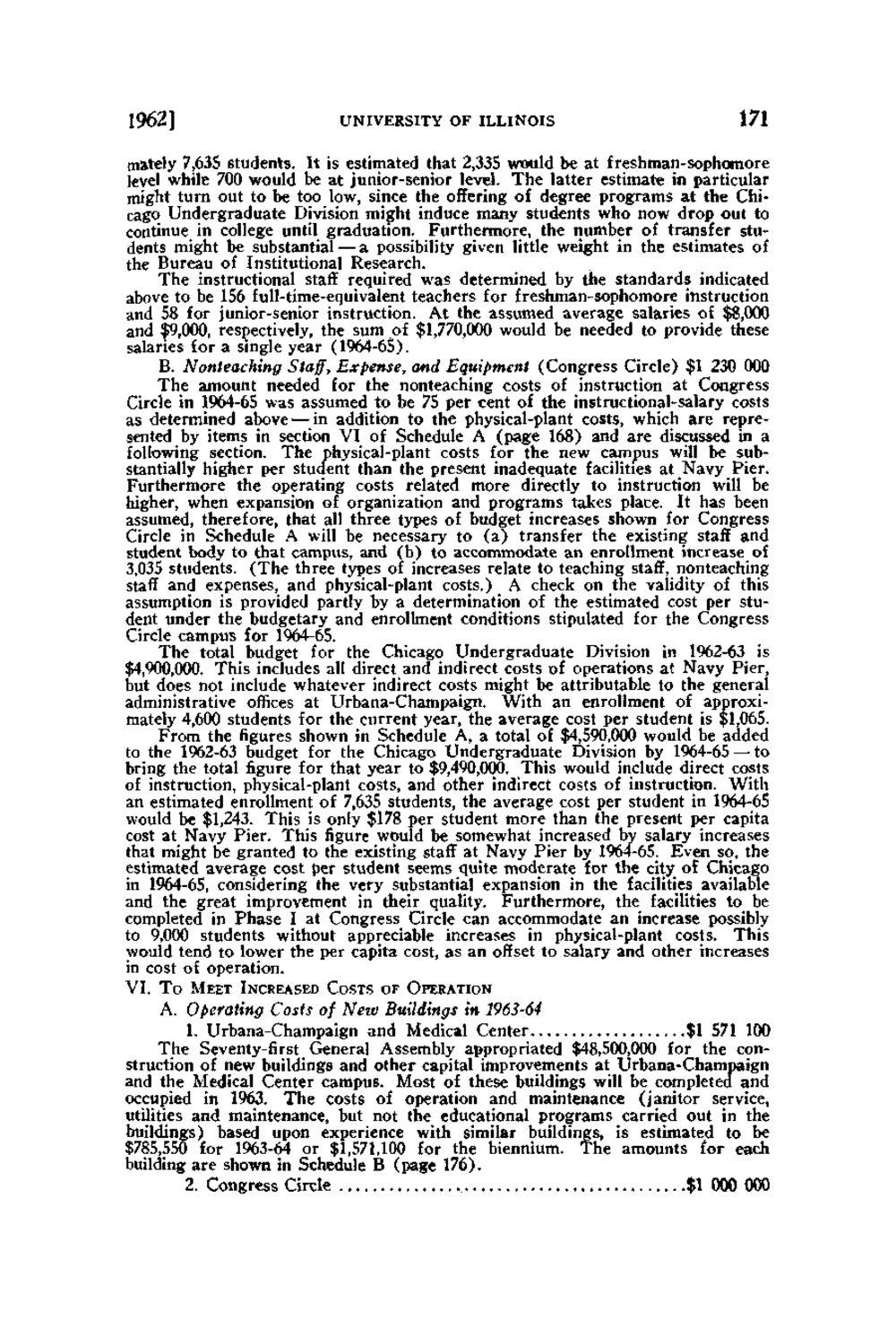| |
| |
Caption: Board of Trustees Minutes - 1964
This is a reduced-resolution page image for fast online browsing.

EXTRACTED TEXT FROM PAGE:
1962] UNIVERSITY OF ILLINOIS 171 mately 7,635 students. It is estimated that 2,335 would be at freshman-sophomore level while 700 would be at junior-senior level. T h e latter estimate in particular might turn out to be too low, since the offering of degree programs at the Chicago Undergraduate Division might induce many students who now drop out to continue in college until graduation. Furthermore, the number of transfer students might be substantial — a possibility given little weight in the estimates of the Bureau of Institutional Research. T h e instructional staff required was determined by the standards indicated above to be 156 full-time-equivalent teachers for freshman-sophomore instruction and 58 for junior-senior instruction. At the assumed average salaries of $8,000 and $9,000, respectively, the sum of $1,770,000 would be needed to provide these salaries for a single year (1964-65). B. Nonteaching Staff, Expense, and Equipment (Congress Circle) $1 230 000 T h e amount needed for the nonteaching costs of instruction at Congress Circle in 1964-65 was assumed to be 75 per cent of the instructional-salary costs as determined above — in addition to the physical-plant costs, which are represented by items in section VI of Schedule A (page 168) and are discussed in a following section. The physical-plant costs for the new campus will be substantially higher per student than the present inadequate facilities at Navy Pier. Furthermore the operating costs related more directly to instruction will be higher, when expansion of organization and programs takes place. It has been assumed, therefore, that all three types of budget increases shown for Congress Circle in Schedule A will be necessary to ( a ) transfer the existing staff and student body to that campus, and ( b ) to accommodate an enrollment increase of 3,035 students. ( T h e three types of increases relate to teaching staff, nonteaching staff and expenses, and physical-plant costs.) A check on the validity of this assumption is provided partly by a determination of the estimated cost per student under the budgetary and enrollment conditions stipulated for the Congress Circle campus for 1964-65. The total budget for the Chicago Undergraduate Division in 1962-63 is $4,900,000. This includes all direct and indirect costs of operations at Navy Pier, but does not include whatever indirect costs might be attributable to the general administrative offices at Urbana-Champaign. With an enrollment of approximately 4,600 students for the current year, the average cost per student is $1,065. From the figures shown in Schedule A, a total of $4,590,000 would be added to the 1962-63 budget for the Chicago Undergraduate Division by 1964-65 — to bring the total figure for that year to $9,490,000. This would include direct costs of instruction, physical-plant costs, and other indirect costs of instruction. With an estimated enrollment of 7,635 students, the average cost per student in 1964-65 would be $1,243. This is only $178 per student more than the present per capita cost at Navy Pier. This figure would be somewhat increased by salary increases that might be granted to the existing staff at Navy Pier by 1964-65. Even so, the estimated average cost per student seems quite moderate for the city of Chicago in 1964-65, considering the very substantial expansion in the facilities available and the great improvement in their quality. Furthermore, the facilities to be completed in Phase I at Congress Circle can accommodate an increase possibly to 9,000 students without appreciable increases in physical-plant costs. This would tend to lower the per capita cost, as an offset to salary and other increases in cost of operation. VI. T o M E E T INCREASED COSTS OF OPERATION A. Operating Costs of New Buildings in 1963-64 1. Urbana-Champaign and Medical Center $1 571 100 T h e Seventy-first General Assembly appropriated $48,500,000 for the construction of new buildings and other capital improvements at Urbana-Champaign and the Medical Center campus. Most of these buildings will be completed and occupied in 1963. T h e costs of operation and maintenance (janitor service, utilities and maintenance, but not the educational programs carried out in the buildings) based upon experience with similar buildings, is estimated to be $785,550 for 1963-64 or $1,571,100 for the biennium. T h e amounts for each building are shown in Schedule B (page 176). 2. Congress Circle $1 000 000
| |